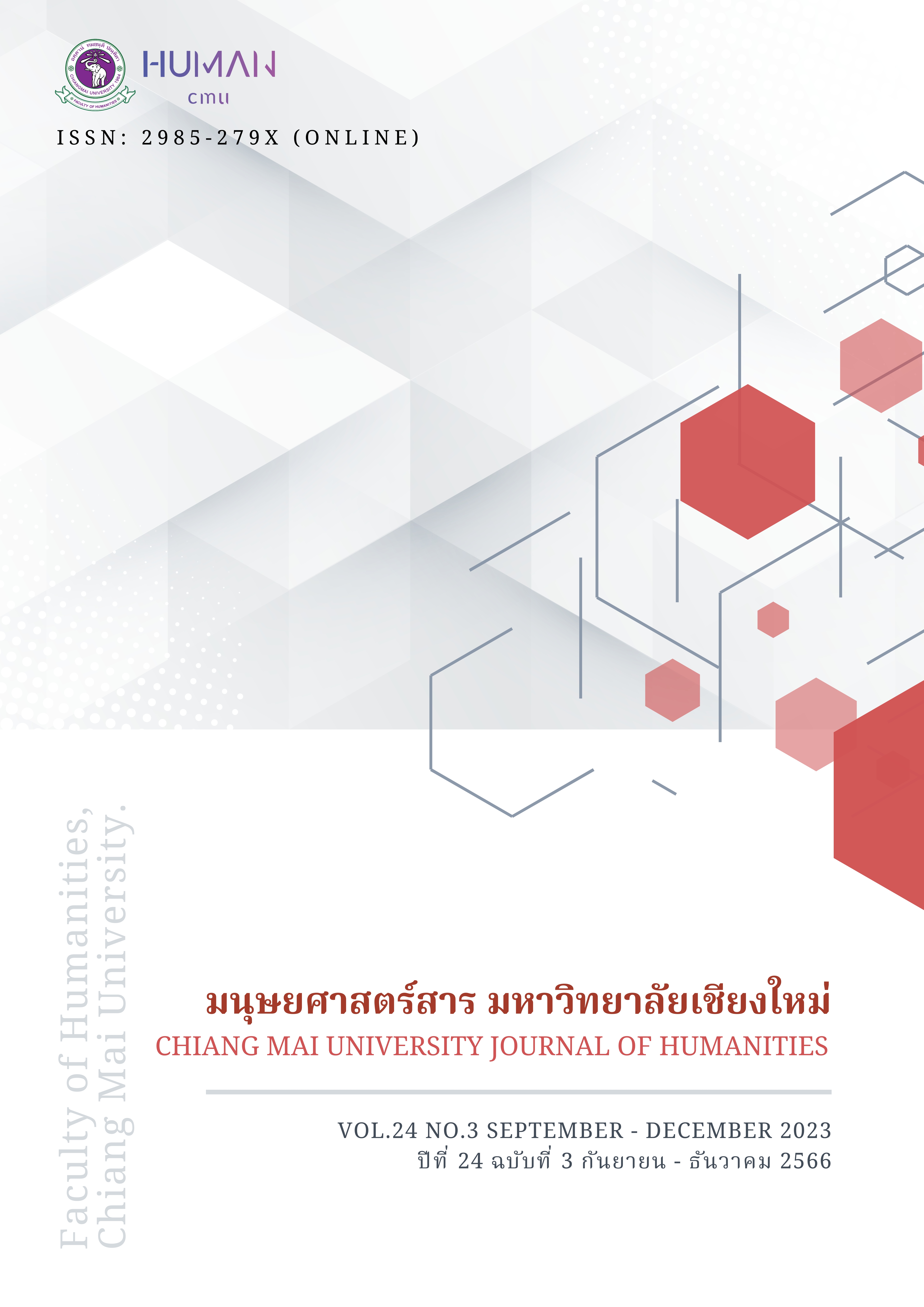การ พัฒนามาตรวัดเพื่อประเมินจิตสำนึกสุจริตและพฤติกรรมสุจริตของบุคลากรภาครัฐ : บริบทของมหาวิทยาลัยเชียงใหม่
Main Article Content
บทคัดย่อ
การวิจัยนี้มีวัตถุประสงค์เพื่อพัฒนามาตรวัดจิตสำนึกและพฤติกรรมสุจริตของบุคลากรภาครัฐภายใต้บริบทของมหาวิทยาลัยเชียงใหม่ และเพื่อศึกษาอำนาจพยากรณ์ของจิตสำนึกสุจริตที่มีต่อพฤติกรรมสุจริต การวิจัยเป็นแบบผสานวิธีแบบเชิงสำรวจเป็นลำดับ แบ่งออกเป็น 3 ระยะ ได้แก่ ระยะที่ 1 เป็นการวิจัยเชิงคุณภาพเพื่อกำหนดคำจำกัดความของจิตสำนึกและพฤติกรรมสุจริต เก็บข้อมูลด้วยวิธีการสัมภาษณ์ กลุ่มเป้าหมายได้แก่ ผู้บริหารของมหาวิทยาลัยเชียงใหม่ จำนวน 11 คน ระยะที่ 2 เป็นการพัฒนามาตรวัดจิตสำนึกและพฤติกรรมสุจริต กลุ่มตัวอย่างเป็นบุคลากรมหาวิทยาลัยเชียงใหม่ จำนวน 817 คน และพนักงานองค์การภาครัฐและเอกชน จำนวน 352 คน สำหรับระยะที่ 3 เป็นการทดสอบสมมติฐานของการวิจัย กลุ่มตัวอย่างที่ 1 เป็นบุคลากรมหาวิทยาลัยเชียงใหม่ และกลุ่มตัวอย่างที่ 2 เป็นผู้บังคับบัญชาโดยตรงของกลุ่มตัวอย่างที่ 1 จำนวนกลุ่มละ 738 คน การวิเคราะห์ข้อมูลในการวิจัยระยะที่ 1 ใช้วิธีการวิเคราะห์เนื้อหา ส่วนการวิเคราะห์ข้อมูลในระยะที่ 2 และ 3 กระทำโดยการใช้โปรแกรม SmartPLS 4.0.8.9 เพื่อประเมินคุณสมบัติเชิงจิตมิติของมาตรวัด และทดสอบสมมติฐานของการวิจัยโดยการวิเคราะห์เส้นอิทธิพล ด้วยโปรแกรม AMOS version 29
ผลการวิจัยระยะที่ 1 พบว่า จิตสำนึกและพฤติกรรมสุจริต ประกอบด้วย 9 ประเด็น ได้แก่ (1) ซื่อสัตย์ มีเจตนาสุจริต (2) โปร่งใส ตรวจสอบได้ (3) ละอายและเกรงกลัวต่อการกระทำผิด (4) รับผิดชอบต่อหน้าที่และการกระทำของตน (5) ปฏิบัติตามกฎระเบียบ (6) ต่อต้านการทุจริต (7) ไม่รับ/ไม่แสวงหาผลประโยชน์ที่ไม่ควรจะได้ (8) ไม่ใช้อำนาจในทางที่ผิด และ (9) ปกป้องและทำเพื่อผลประโยชน์ขององค์การ ผลการวิจัยระยะที่ 2 พบว่า มาตรวัดที่พัฒนาขึ้นมีคุณสมบัติเชิงจิตมิติที่เหมาะสม ผลการวิจัยระยะที่ 3 พบว่า บุคลากรมหาวิทยาลัยเชียงใหม่มีจิตสำนึกและพฤติกรรมสุจริตอยู่ในระดับสูง และพบว่า จิตสำนึกสุจริตมีอิทธิพลทางตรงต่อพฤติกรรมสุจริตของบุคลากร
Article Details

อนุญาตภายใต้เงื่อนไข Creative Commons Attribution-NonCommercial-NoDerivatives 4.0 International License.
เอกสารอ้างอิง
ชูชัย สมิทธิไกร, วีรวรรณ วงศ์ปิ่นเพ็ชร์, ฉัตรวิบูลย์ ไพจ์เซล, ทัศนีย์ หอมกลิ่น, และพลภัทร เจริญเวียงเวชกิจ (2566). รายงานการวิจัยเรื่อง การพัฒนามาตรวัดจิตสำนึกสุจริตและพฤติกรรมสุจริตสำหรับบุคลากรมหาวิทยาลัยเชียงใหม่. มหาวิทยาลัยเชียงใหม่.
สำนักงานคณะกรรมการป้องกันและปราบปรามการทุจริตแห่งชาติ (2566) . https://itas.nacc.go.th/
report/rpt0202?Year=2023&AssessmentId=182&Keyword=&MinistryId=&DepartmentCatId=&ProvinceId=&IsPublic=True
มหาวิทยาลัยเชียงใหม่. (2564). คู่มือการประเมินคุณธรรมและความโปร่งใสในการดำเนินงานของส่วนงาน มหาวิทยาลัยเชียงใหม่ประจำปีงบประมาณ พ.ศ. 2565. https://ita.library.cmu.ac.th/api/assets/
manuals/1/Book-CMU-ITA-2022_2022020204034416.pdf
Aquino, K., & Freeman, D. (2009). Workplace deviance: The role of voluntary work behaviors. In J. Greenberg & J. A. Colquitt (Eds.), Handbook of Organizational Justice (pp. 555-578). Lawrence Erlbaum Associates.
Aquino, K., & Reed, A. (2002). The self-importance of moral identity. Journal of Personality and Social Psychology, 83(6), 1423-1440. https://doi.org/10.1037/0022-3514.83.6.1423
Baxter, J., Dempsey, J., Megone, C., & Lee, J. (2012). Real Integrity: Practical solution for organizations seeking to promote and encourage integrity. ICAEW.
Becker, T. E. (1998). Integrity in organizations: Beyond honesty and conscientiousness. Academy of Management Review, 23(1), 154-161. https://doi.org/10.5465/amr.1998.
Black, J. E., & Reynolds, W. M. (2016). Development, reliability, and validity of the Moral Identity Questionnaire. Personality and Individual Differences, 97, 120–129. https://doi.org/10.1016/j.paid.2016.03.041
Blasi, A. (1984). Moral identity: Its role in moral functioning. In W. Kurtines & J. Gewirtz, (Eds.) Morality, Moral Behavior and Moral Development (pp. 128-139). Wiley.
Cambridge University. (2023). Cambridge dictionary. Cambridge University Press. Online: https://dictionary.cambridge.org/dictionary/english/integrity
Conway, J. M., & Huffcutt, A. I. (1997). Psychometric properties of multisource performance ratings: A meta-analysis of subordinate, supervisor, peer, and self-ratings. Human Performance, 10(4), 331–360. https://doi.org/10.1207/s15327043hup1004_2
Creswell J. W. & Clark, V. P. (2007). Designing and conducting mixed methods research. SAGE.
Cunningham, M. R. (1989). Test-taking motivations and outcomes on a standardized measure of on-the-job integrity. Journal of Business Psychology, 4, 119-127. https://doi.org/10.
/BF01023042.
Endler, N. S., & Magnusson, D. (Eds). (1976). Interactional psychology and personality. Halsted.
Fornell, C. & Larcker, D. F. (1981). Evaluating structural equation models with unobservable variables and measurement error. Journal of Marketing Research, 18, 39-50. https://doi.org/10.2307/3151312
Gino, F., & Pierce, L. (2010). The abundance effect: Unethical behavior in the presence of wealth. Organizational Behavior and Human Decision Processes, 113(2), 97-105. https://doi.org/10.1016/j.obhdp.2010.03.001
Goodin, R. E. (2010). An epistemic case for legal moralism. Oxford Journal of Legal Studies, 30(4), 615–633. https://doi.org/10.1093/ojls/gqq026
Hair, J. F., Hult, G. T. M., Ringle, C. M., & Sarstedt, M. (2017). A primer on partial least squares structural equation modeling (PLS-SEM) (2nd Ed). Sage.
Harris, M. M., & Schaubroeck, J. (1988). A meta-analysis of self-supervisor, self-peer, and peer-supervisor ratings. Personnel Psychology, 41(1), 43–62. Portico. https://doi.org/10.1111/
j.1744-6570.1988.tb00631.x
Heidemeier, H., & Moser, K. (2009). Self–other agreement in job performance ratings: A meta-analytic test of a process model. Journal of Applied Psychology, 94(2), 353–370. https://doi.org/10.1037/0021-9010.94.2.353
Henseler, J., Hubona, G. S. & Pauline, A. R. (2016). Using PLS path modeling in new technology research: Updated guidelines. Industrial Management & Data Systems, 116 (1), 2-20. https://doi.org/10.1108/imds-09-2015-0382
Hilgard, E. R. (1980). The trilogy of mind: Cognition, affection, and conation. Journal of the History of the Behavioral Sciences, 16(2), 107-117. https://doi.org/10.1002/1520-6696(198004)16:2<107::aid-jhbs2300160202>3.0.co;2-y
Hinkin, T. R. (1995). A review of scale development practices in the study of organizations. Journal of Management, 21(5), 967–988. https://doi.org/10.1177/014920639502100509
Kolthoff, E.W. (2007). Ethics and new public management: Empirical research into the effects of businesslike government on ethics and integrity. BJU Legal Publishers.
Krambia-Kapardis, M., & Zopiatis, A. (2014). The influence of corporate social responsibility on consumers' attitudes and intentions toward luxury hotels. International Journal of Contemporary Hospitality Management, 26(2), 272-292. https://doi.org/10.1108/IJCHM-08-2012-0097
Krettenauer, T., Lefebvre, J. P., Hardy, S. A., Zhang, Z., & Cazzell, A. R. (2021). Daily moral identity: Linkages with integrity and compassion. Journal of Personality, 90(5), 663–674. Portico. https://doi.org/10.1111/jopy.12689
Mischel, W. (1977). The interaction of person and situation. In D. Magnusson & N. S. Endler (Eds.), Personality at the crossroads: Current issues in interactional psychology (pp. 333–352). Lawrence Erlbaum Associates.
Mohyeldin, T. & Suliman, A. (2003). Self and supervisor ratings of performance. Employee Relations, 25(4), 371–388. https://doi.org/10.1108/01425450310483389
Neuman, W. L. (1991). Social research methods: Qualitative and quantitative approaches. Allyn and Bacon.
Ones, D. S., Viswesvaran, C. H., & Schmidt, F. L. (1993). Comprehensive meta-analysis of integrity test validities: Findings and implications for personnel selection and theories of job performance. Journal of Applied Psychology, 78(4), 679-703. https://doi.org/10.1037/
-9010.78.4.679
Palanski, M. E., & Yammarino, F. J. (2007). Integrity and leadership: Clearing the conceptual confusion. European Management Journal, 25(3), 171-184. https://doi.org/10.1016/
j.emj.2007.04.006
PriceWaterhouseCoopers. (2022). PwC’s global economic crime and fraud survey 2022 -Thailand report. https://www.pwc.com/th/en/consulting/forensic/assets/eco-nomic-crime-and-fraud-survey-2022.pdf
Rest, J. R., Narvaez, D., Thoma, S. J., & Bebeau, M. J. (2000). A neo-Kohlbergian approach to morality research. Journal of Moral Education, 29(4), 381-395. https://doi.org/10.1080/
Reynolds, S. J., & Ceranic, T. L. (2007). The effects of moral judgment and moral identity on moral behavior: An empirical examination of the moral individual. Journal of Applied Psychology, 92(6), 1610-1624. https:// doi.org/10.1037/0021-9010.92.6.1610
Ringle, C. M., Wende, S., & Becker, J. (2022). SmartPLS 4. Oststeinbek: SmartPLS. https://www.smartpls.com
Sarstedt, M., Hair, J. F., Cheah, J.-H., Becker, J.-M., & Ringle, C. M. (2019). How to specify, estimate, and validate higher-order constructs in PLS-SEM. Australasian Marketing Journal, 27(3), 197-211. https://doi.org/10.1016/j.ausmj.2019.05.003
Sheeran, P. (2005). Intention-behavior relations: A conceptual and empirical review. European Review of Social Psychology, 1-36. https://doi.org/10.1002/0470013478.ch1
Transparency International. (2023). Corruption perceptions index 2022. https://reliefweb.int/
attachments/0b61e9c2-df7e-440d-b7be-e96e6948fd83/Report_CPI2022_English.pdf
Wanek, J. E. (1999). Integrity and Honesty Testing: What Do We Know? How Do We Use It? International Journal of Selection and Assessment, 7(4), 183–195. Portico. https://doi.org/10.1111/1468-2389.00118


